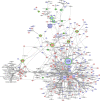White adipose tissue reference network: a knowledge resource for exploring health-relevant relations
- PMID: 25466819
- PMCID: PMC4252261
- DOI: 10.1007/s12263-014-0439-x
White adipose tissue reference network: a knowledge resource for exploring health-relevant relations
Abstract
Optimal health is maintained by interaction of multiple intrinsic and environmental factors at different levels of complexity-from molecular, to physiological, to social. Understanding and quantification of these interactions will aid design of successful health interventions. We introduce the reference network concept as a platform for multi-level exploration of biological relations relevant for metabolic health, by integration and mining of biological interactions derived from public resources and context-specific experimental data. A White Adipose Tissue Health Reference Network (WATRefNet) was constructed as a resource for discovery and prioritization of mechanism-based biomarkers for white adipose tissue (WAT) health status and the effect of food and drug compounds on WAT health status. The WATRefNet (6,797 nodes and 32,171 edges) is based on (1) experimental data obtained from 10 studies addressing different adiposity states, (2) seven public knowledge bases of molecular interactions, (3) expert's definitions of five physiologically relevant processes key to WAT health, namely WAT expandability, Oxidative capacity, Metabolic state, Oxidative stress and Tissue inflammation, and (4) a collection of relevant biomarkers of these processes identified by BIOCLAIMS ( http://bioclaims.uib.es ). The WATRefNet comprehends multiple layers of biological complexity as it contains various types of nodes and edges that represent different biological levels and interactions. We have validated the reference network by showing overrepresentation with anti-obesity drug targets, pathology-associated genes and differentially expressed genes from an external disease model dataset. The resulting network has been used to extract subnetworks specific to the above-mentioned expert-defined physiological processes. Each of these process-specific signatures represents a mechanistically supported composite biomarker for assessing and quantifying the effect of interventions on a physiological aspect that determines WAT health status. Following this principle, five anti-diabetic drug interventions and one diet intervention were scored for the match of their expression signature to the five biomarker signatures derived from the WATRefNet. This confirmed previous observations of successful intervention by dietary lifestyle and revealed WAT-specific effects of drug interventions. The WATRefNet represents a sustainable knowledge resource for extraction of relevant relationships such as mechanisms of action, nutrient intervention targets and biomarkers and for assessment of health effects for support of health claims made on food products.
Figures



Similar articles
-
Stimulation of mitochondrial oxidative capacity in white fat independent of UCP1: a key to lean phenotype.Biochim Biophys Acta. 2013 May;1831(5):986-1003. doi: 10.1016/j.bbalip.2013.02.003. Epub 2013 Feb 20. Biochim Biophys Acta. 2013. PMID: 23454373
-
Network-based integration of molecular and physiological data elucidates regulatory mechanisms underlying adaptation to high-fat diet.Genes Nutr. 2015 Jul;10(4):470. doi: 10.1007/s12263-015-0470-6. Epub 2015 May 28. Genes Nutr. 2015. PMID: 26017391 Free PMC article.
-
Beiging of white adipose tissue as a therapeutic strategy for weight loss in humans.Horm Mol Biol Clin Investig. 2017 Jun 23;31(2):/j/hmbci.2017.31.issue-2/hmbci-2017-0016/hmbci-2017-0016.xml. doi: 10.1515/hmbci-2017-0016. Horm Mol Biol Clin Investig. 2017. PMID: 28672737 Review.
-
Omega-3 fatty acids and adipose tissue biology.Mol Aspects Med. 2018 Dec;64:147-160. doi: 10.1016/j.mam.2018.01.004. Epub 2018 Jan 17. Mol Aspects Med. 2018. PMID: 29329795 Review.
-
Identification of key candidate genes and molecular pathways in white fat browning: an anti-obesity drug discovery based on computational biology.Hum Genomics. 2019 Nov 7;13(1):55. doi: 10.1186/s40246-019-0239-x. Hum Genomics. 2019. PMID: 31699147 Free PMC article.
Cited by
-
Systems view of adipogenesis via novel omics-driven and tissue-specific activity scoring of network functional modules.Sci Rep. 2016 Jul 7;6:28851. doi: 10.1038/srep28851. Sci Rep. 2016. PMID: 27385551 Free PMC article.
-
Navigating the disease landscape: knowledge representations for contextualizing molecular signatures.Brief Bioinform. 2019 Mar 25;20(2):609-623. doi: 10.1093/bib/bby025. Brief Bioinform. 2019. PMID: 29684165 Free PMC article. Review.
-
Human nutrition, environment, and health.Genes Nutr. 2015 Sep;10(5):489. doi: 10.1007/s12263-015-0489-8. Genes Nutr. 2015. PMID: 26319142 Free PMC article. No abstract available.
-
Modeling-Enabled Systems Nutritional Immunology.Front Nutr. 2016 Feb 16;3:5. doi: 10.3389/fnut.2016.00005. eCollection 2016. Front Nutr. 2016. PMID: 26909350 Free PMC article. Review.
-
Systems biology of personalized nutrition.Nutr Rev. 2017 Aug 1;75(8):579-599. doi: 10.1093/nutrit/nux029. Nutr Rev. 2017. PMID: 28969366 Free PMC article. Review.
References
-
- Ade AS, Wright ZC, States DJ (2007) Gene2MeSH. http://gene2mesh.ncibi.org/. Accessed 12 May 2014
LinkOut - more resources
Full Text Sources
Other Literature Sources

